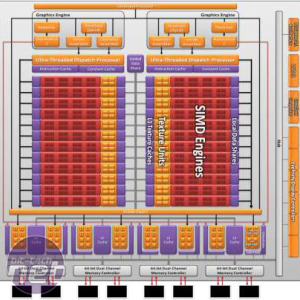Radeon HD 6950 2GB Specifications
While the Barts GPU of the HD 6800-series was a bit same-old, same-old, the new Cayman GPU of the HD 6900 is a big change. For a start, there’s two entire Front-End Engines, so the Cayman GPU has two triangle setup units, two tessellators and can send twice as much work per clock to the stream processors as previous Radeon GPUs.Those stream processors have been upgraded, so they’re all capable of the high-precision work that only a fifth of the stream processors of previous generations were able to calculate. They’re organised in groups of four, with 16 of these groups per SIMD Engine (or stream processors cluster).
While this means that the HD 6970 2GB has fewer stream processors than the HD 5870 1GB, they’re more capable. ATI says the new layout, called VLIW4, is 10 per cent faster per mm2.
However, the HD 6950 2GB has even fewer stream processors, with only 22 SIMD Engines rather than 24, meaning it has a total of 1,408 stream processors. The lesser number of SIMD Engines means there are fewer texture units in the HD 6950 2GB than the HD 6970 2GB as well. The HD 6950 2GB runs at 800MHz rather than 880MHz.
The ROPs have seen upgrades too, and both HD 6900-series cards will have 2GB of GDDR5 memory running at comparably high frequencies to give the large amount of memory bandwidth from the 256-bit memory interface. While the memory of HD 6970 2GB runs at an astounding 5.5GHz (effective), the HD 6950 2GB has 5GHz (effective) memory, meaning it has 160GB/sec of memory bandwidth rather than 176GB/sec.
| ATI Radeon HD 6970 2GB | Nvidia GeForce GTX 570 1.5GB | ATI Radeon HD 6950 2GB | ATI Radeon HD 5870 1GB | ATI Radeon HD 6870 1GB | Nvidia GeForce GTX 460 1GB | |
| GPU | ||||||
| Codename | Cayman XT | GF110 | Cayman Pro | Cypress XT | Barts XT | GF104 |
| Frequency | 880MHz | 732MHz | 800MHz | 850MHz | 900MHz | 675MHz |
| Stream Processors | 1,536 (880MHz) | 480 (1,464MHz) | 1,408 (800MHz) | 1,600 (850MHz) | 1,120 (900MHz) | 336 (1,215MHz) |
| Layout | 24 SIMD Engines | 15 SMs, 4 GPCs | 22 SIMD Engines | 20 SIMD Engines | 14 SIMD Engines | 7 SMs, 2 GPCs |
| Rasterisers | 2 | 4 | 2 | 2 | 2 | 2 |
| Tesselation Units | 2 | 15 | 2 | 1 | 1 | 8 |
| Texture Units | 96 | 60 | 88 | 80 | 56 | 56 |
| ROPs | 32 | 40 | 32 | 32 | 32 | 32 |
| Transistors | 3.6bn | 3bn | 2.6bn | 2.15bn | 1.7bn | 1.95bn |
| Size | Unknown | Unknown | Unknown | 334mm2 | 255mm2 | Unknown |
| Process | 40nm | 40nm | 40nm | 40nm | 40nm | 40nm |
| Memory | ||||||
| Amount | 2GB GDDR5 | 1,280MB GDDR5 | 2GB GDDR5 | 1GB GDDR5 | 1GB GDDR5 | 1GB GDDR% |
| Frequency | 1.375GHz (5.5GHz effective) | 950MHz (3.8GHz effective) | 1.25GHz (5GHz effective) | 1,050MHz (4.2GHz effective) | 1,050MHz (4.2GHz effective) | 900MHz (3.6GHz effective) |
| Interface | 256-bit | 320-bit | 256-bit | 256-bit | 256-bit | 256-bit |
| Bandwidth | 176GB/sec | 152GB/sec | 160GB/sec | 134.4GB/sec | 134.4GB/sec | 115GB/sec |
| Card Specifications | ||||||
| Power Connectors | 1 x 6-pin, 1 x 8-pin | 2 x 6-pin PCI-E | 2 x 6-pin PCI-E | 2 x 6-pin PCI-E | 2 x 6-pin PCI-E | 2 x 6-pin PCI-E |
| Maximum Power Draw | 250W | 219W | 225W | 188W | 151W | 160W |
| Idle Power Draw | Unknown | Unknown | Unknown | 27W | 19W | Unknown |
| Recommended PSU | Unknown | 550W | Unknown | 500W | Unknown | 450W |
| Typical Street Price | £310 | £300 | £235 | £320 | £220 | £155 |

MSI MPG Velox 100R Chassis Review
October 14 2021 | 15:04










Want to comment? Please log in.